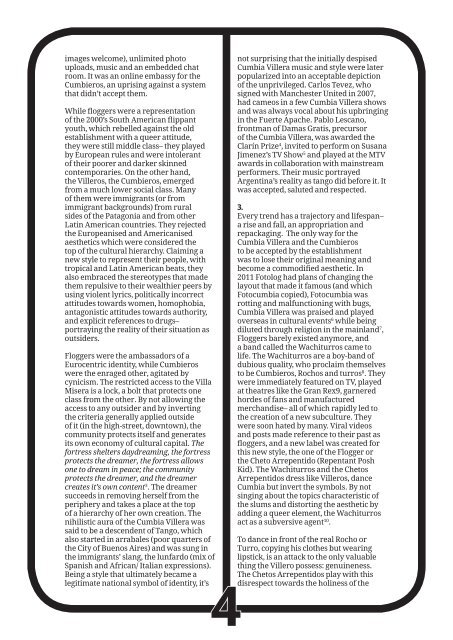You also want an ePaper? Increase the reach of your titles
YUMPU automatically turns print PDFs into web optimized ePapers that Google loves.
images welcome), unlimited photouploads, music and an embedded chatroom. It was an online embassy for theCumbieros, an uprising against a systemthat didn’t accept them.While floggers were a representationof the 2000’s South American flippantyouth, which rebelled against the oldestablishment with a queer attitude,they were still middle class– they playedby European rules and were intolerantof their poorer and darker skinnedcontemporaries. On the other hand,the Villeros, the Cumbieros, emergedfrom a much lower social class. Manyof them were immigrants (or fromimmigrant backgrounds) from ruralsides of the Patagonia and from otherLatin American countries. They rejectedthe Europeanised and Americanisedaesthetics which were considered thetop of the cultural hierarchy. Claiming anew style to represent their people, withtropical and Latin American beats, theyalso embraced the stereotypes that madethem repulsive to their wealthier peers byusing violent lyrics, politically incorrectattitudes towards women, homophobia,antagonistic attitudes towards authority,and explicit references to drugs–portraying the reality of their situation asoutsiders.Floggers were the ambassadors of aEurocentric identity, while Cumbieroswere the enraged other, agitated bycynicism. The restricted access to the VillaMisera is a lock, a bolt that protects oneclass from the other. By not allowing theaccess to any outsider and by invertingthe criteria generally applied outsideof it (in the high-street, downtown), thecommunity protects itself and generatesits own economy of cultural capital. Thefortress shelters daydreaming, the fortressprotects the dreamer, the fortress allowsone to dream in peace; the communityprotects the dreamer, and the dreamercreates it’s own content 3 . The dreamersucceeds in removing herself from theperiphery and takes a place at the topof a hierarchy of her own creation. Thenihilistic aura of the Cumbia Villera wassaid to be a descendent of Tango, whichalso started in arrabales (poor quarters ofthe City of Buenos Aires) and was sung inthe immigrants’ slang, the lunfardo (mix ofSpanish and African/ Italian expressions).Being a style that ultimately became alegitimate national symbol of identity, it’s4not surprising that the initially despisedCumbia Villera music and style were laterpopularized into an acceptable depictionof the unprivileged. Carlos Tevez, whosigned with Manchester United in 2007,had cameos in a few Cumbia Villera showsand was always vocal about his upbringingin the Fuerte Apache. Pablo Lescano,frontman of Damas Gratis, precursorof the Cumbia Villera, was awarded theClarín Prize 4 , invited to perform on SusanaJimenez’s TV Show 5 and played at the MTVawards in collaboration with mainstreamperformers. Their music portrayedArgentina’s reality as tango did before it. Itwas accepted, saluted and respected.3.Every trend has a trajectory and lifespan–a rise and fall, an appropriation andrepackaging. The only way for theCumbia Villera and the Cumbierosto be accepted by the establishmentwas to lose their original meaning andbecome a commodified aesthetic. In2011 Fotolog had plans of changing thelayout that made it famous (and whichFotocumbia copied), Fotocumbia wasrotting and malfunctioning with bugs,Cumbia Villera was praised and playedoverseas in cultural events 6 while beingdiluted through religion in the mainland 7 ,Floggers barely existed anymore, anda band called the Wachiturros came tolife. The Wachiturros are a boy-band ofdubious quality, who proclaim themselvesto be Cumbieros, Rochos and turros 8 . Theywere immediately featured on TV, playedat theatres like the Gran Rex9, garneredhordes of fans and manufacturedmerchandise– all of which rapidly led tothe creation of a new subculture. Theywere soon hated by many. Viral videosand posts made reference to their past asfloggers, and a new label was created forthis new style, the one of the Flogger orthe Cheto Arrepentido (Repentant PoshKid). The Wachiturros and the ChetosArrepentidos dress like Villeros, danceCumbia but invert the symbols. By notsinging about the topics characteristic ofthe slums and distorting the aesthetic byadding a queer element, the Wachiturrosact as a subversive agent 10 .To dance in front of the real Rocho orTurro, copying his clothes but wearinglipstick, is an attack to the only valuablething the Villero possess: genuineness.The Chetos Arrepentidos play with thisdisrespect towards the holiness of the








